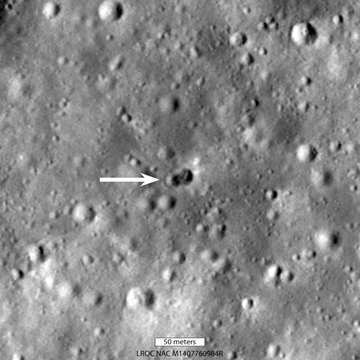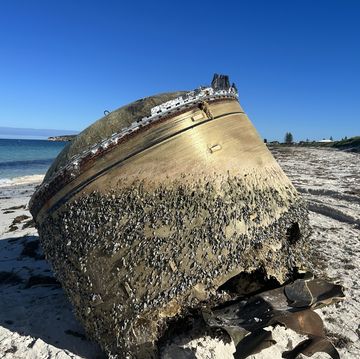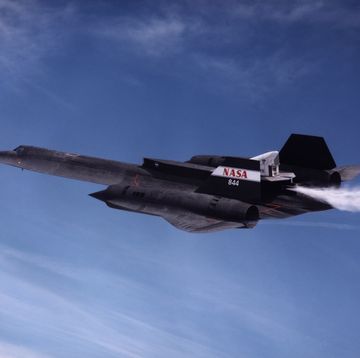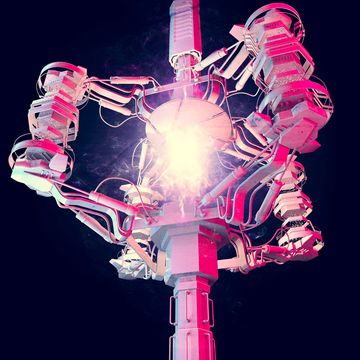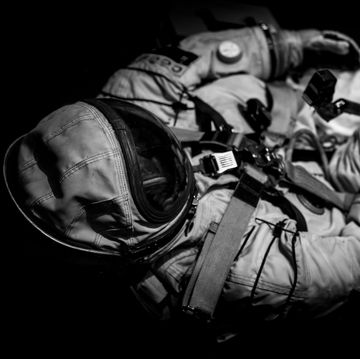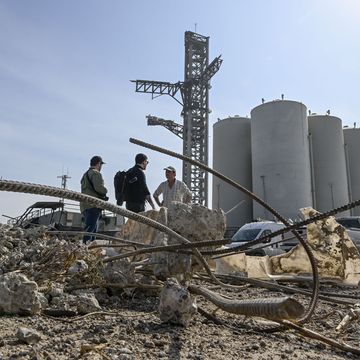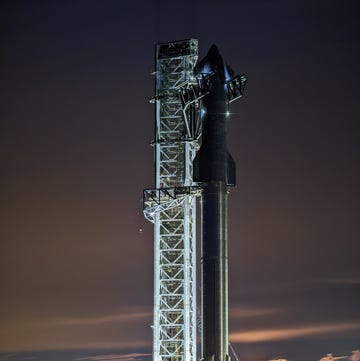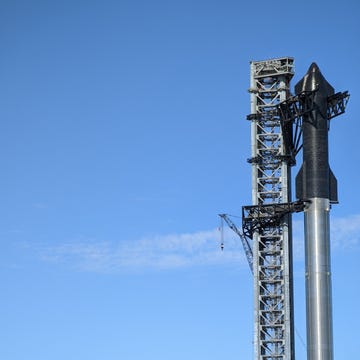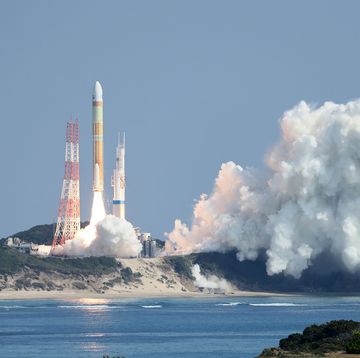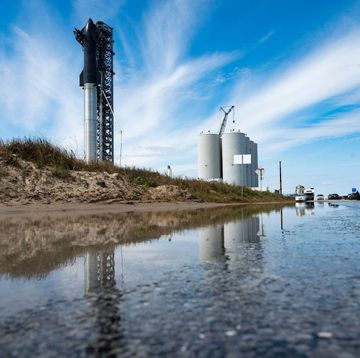In late 2001, Tom Mueller was sacrificing his nights and weekends to build a liquid-fuel rocket engine in his garage.
Mueller, a propulsion engineer at Redondo Beach, Calif.–based aerospace firm TRW, felt like an "unwanted necessity" at his day job. His prolific ideas about engine design were lost at such a large, diverse company. To satisfy his creative impulses, he built his own engines, attached them to airframes and launched them in the Mojave Desert with fellow enthusiasts in the Reaction Research Society, America's oldest amateur rocketry club. RRS members, many of them employees at aerospace firms, meet regularly in the Los Angeles area to build and launch the biggest and highest flying rockets they can—just as the group has done since it was founded in the early 1940s.
Building a liquid-fuel rocket engine isn't easy, even for an experienced propulsion engineer. Liquid propellants are cheap and provide lots of lifting power, but the engines rely on a host of valves and seals to control the flow. And they usually require supercooled oxidizers, like liquid oxygen, to mix with the fuel so it can ignite. The resulting combustion—essentially a controlled explosion—is channeled at high pressure into the nozzle, creating the thrust that propels the rocket. Despite these challenges, by early 2002 Mueller had moved his operations to a friend's rented warehouse and was putting the finishing touches on the world's largest amateur liquid-fuel rocket engine, an 80-pounder designed to produce 13,000 pounds of thrust.
Mueller's ambitious moonlighting caught the attention of Internet multimillionaire Elon Musk, who met the engineer at the warehouse in January 2002 as Mueller was trying to attach his homemade engine to an airframe. Fresh from the $1.5 billion sale of PayPal to eBay, Musk was seeking staff for a new space company, soon to be called Space Exploration Technologies, or SpaceX. He eyed the rocket engine and asked a simple question: "Can you build something bigger?"
Mueller never fired that engine. He took it back to his garage, where it still sits. Instead, he took up Musk's offer to join the nascent private space venture.
Today SpaceX has more than 700 employees, 500 of them at corporate headquarters in Hawthorne, Calif. Mueller is vice president of propulsion. "TRW is a huge company with a tiny propulsion department," Mueller says. "Here, I'm kind of king."
On the floor of the Hawthorne facility, a former Boeing 747 assembly plant, rests the engine assembly from SpaceX's Falcon 9 rocket. Soot from a test firing coats the 12-foot-high structure. Seven of nine engines are in place; technicians have removed the other two and stood them upright on nozzles nearly 3 feet wide. Topped with a 3200-hp turbopump and a tangle of plumbing, each engine stands taller than a man.
Once all nine engines have been refurbished, the assembly will be shipped to the company's test center in McGregor, Texas. Firing one engine to simulate a run to orbit awakens babies in towns miles away. The full cluster, which produces nearly 1 million pounds of thrust, must have them bouncing in their cribs like jumping beans.
Last year, NASA awarded SpaceX a $1.6 billion contract to send cargo to the space station; it also issued a $1.9 billion contract to another company, Orbital Sciences. This marks the first time NASA has included private launch vehicles in its plans. "NASA is counting on them," says William Gerstenmaier, the agency's associate administrator responsible for space operations.
Early next year a SpaceX rocket will approach the station in a test flight, with another test to follow in rehearsal for an unmanned docking by the end of 2010. "I never thought that I'd be doing a big program for NASA," Musk says. "It's kind of wild. Launching from Cape Canaveral is like opening on Broadway."
Before Musk made his millions, he identified three main areas that he thought could provide maximum benefit to humanity: the Internet, renewable energy and space exploration. After the windfall sale of PayPal, he scratched the Internet off his list. Within a year of the sale, Musk invested in a pair of companies, electric-car developer Tesla Motors and the solar-power outfit SolarCity, to help foster alternative-energy research. That left space exploration—"in particular the extension of life beyond Earth," he says —as the last item on the list.
Musk wanted to finance a Mars lander, but he discovered it would cost more to launch the craft than to build it. He decided that what the world really needed was affordable rockets. So he searched the ranks of the RRS for engineers who could achieve results on a budget and found a strong candidate for propulsion chief in Mueller. "Tom had an awesome track record of engine development at TRW," Musk says. "I also really liked the fact that he built and tested rocket hardware with his own hands."
With the resources of SpaceX, Mueller was able to produce a reliable engine with a simple design at a cut-rate price—the Merlin. It was the nation's first new large liquid-fuel rocket engine to fly in 40 years. The Merlin runs on highly refined kerosene and cryogenically cooled liquid oxygen, and uses a single injector, unlike more complicated engines that mix fuel and oxidizers at multiple points. But, even with modern technology, rocket engines are notoriously unpredictable.
To prevent heat damage, Mueller treated the nozzles of the early versions of the Merlin with resin impregnated with silicon fibers. This ablative coating chars and flakes off as the engine runs, taking damaging heat with it. The goal was to have an engine that could withstand a punishing 160-second burn—long enough for the first stage of SpaceX's Falcon 1 rocket to reach an altitude of 56 miles, where the second stage's smaller engine kicks in to boost the cargo to 81 miles and low Earth orbit.
In October 2003 Mueller and his engineers sat in the SpaceX control bunker in Texas and fired up a Merlin on the test stand. During the 60-second run, the exhaust began to melt the metal in the engine's throat. The heat also endangered seals that governed the flow of the propellant. If the engine had run any longer, it would have blown up.
It took months to work out the bugs. Mueller's team reduced the amount of liquid oxygen entering the injector to make the engine run cooler and less powerfully, and strengthened the seals. Fifteen months after that first test, the engineers invited me to join them in the bunker as they attempted to run the engine for a full mission duty cycle—the time needed to send a payload into orbit. After a tense countdown, the engineers watched on wide-screen TV monitors as the engine coughed and then blazed to life. A caged-beast roar penetrated the concrete and packed earth walls of the bunker; the steel grates of the test stand's floor shivered and rattled, finally shaking loose a panel that danced across our field of view. The engine ran flawlessly, shutting down after 162.2 seconds when its fuel tank ran dry. After the sudden silence, the room erupted in cheers. "Call Elon!" Mueller yelled. "Tell him we just ran a full duration!"
Building a reliable engine was only the start of the engineering challenges. In 2006, technicians mounted the Merlin engine on SpaceX's 70-foot-tall Falcon 1 rocket and launched it from the company's facility at Kwajalein Atoll, 2500 miles southwest of Hawaii. The liftoff looked perfect, but the rocket was doomed before ignition.
During weeks of preflight tests, salty Pacific air had corroded an aluminum nut in the engine. Just before liftoff, when the propellant valves opened, the nut failed and caused a leak. When the engines ignited 2 seconds before liftoff, the spilled fuel caught fire. Thirty-four seconds after the Falcon launched, flames burned through a pneumatic line and shut down the engine. The rocket crashed into the Pacific a few seconds later.
It was the first in a series of failed launches. A year later, sloshing fuel in the second stage of another Falcon 1 caused oscillations, and the rocket spun out of control before reaching orbit. During the third flight in August 2008, the first stage collided with the second stage just after separation. Both fell into the ocean. An investigation showed that engine improvements had increased residual thrust, leading to the impact.
Less than two months later, those expensive and embarrassing failures were forgotten. At SpaceX's Hawthorne headquarters, Mueller, Musk and the staff watched a video feed from Kwajalein as another Falcon I roared from its South Pacific launchpad. Images from cameras mounted on the rocket showed the first stage falling back to Earth and the second-stage engine kicking on, boosting the rocket into space.
The fairings at the tip of the Falcon separated and fell away; they would eventually incinerate while re-entering the atmosphere. Less than 10 minutes after liftoff, at 16,400 mph and 81 miles—fast enough and high enough to remain in orbit—the Falcon released a dummy payload. Musk and Mueller had created the first private liquid-fuel rocket to reach orbit.
Soon after that successful launch, customers began signing up for future flights on the larger, far more powerful Falcon 9. The rocket's nine engines give it an important asset: reliability. It is the first since the Saturn series from the Apollo program to incorporate engine-out capability—that is, one or more engines can fail and the rocket will still make it to orbit.
According to its launch manifest, the company will boost the payload of the first customer, U.K.-based Avanti Communications, by the end of this year on a Falcon 9. Four other outfits have placed orders through 2015. SpaceX's fees for launching payloads on a Falcon 1 start at around $8 million, a bargain compared to the estimated $13.5 million charged by competitors. A 2009 Government Accountability Office report confirms that the company manufactures almost all of its own rocket components, avoiding dependency on costly external suppliers. "SpaceX has a great deal of in-house technical skill," says Alan Lindenmoyer, NASA's commercial crew and cargo program manager. "But they also have the entrepreneurial spirit that drives them to succeed."
Elon Musk's spaceship, the Dragon, sits on the shop floor in Hawthorne; technicians are preparing the full-size capsule for vibration tests by installing weights to stand in for uncompleted avionics and other gear that will be stored in the unpressurized equipment hold in the Dragon's base. A hatch opens to a second hold pressurized for cargo that cannot survive the vacuum of space. Staff have painted an indigo dragon on the hull, wings outstretched. The image evokes the twin solar panels that will open from the capsule to provide power during extended missions, such as those for microgravity experiments.
Despite the pressure of the NASA contract and the demands of SpaceX's other clients, Musk is still chasing his dream of sending people beyond Earth. NASA has not yet asked the company to build any hardware to carry astronauts to the space station, but SpaceX engineers are preparing the Dragon capsule to handle a crew of seven. Every Dragon spacecraft, even ones that will only carry cargo, has windows. I climb a short metal ladder to the pressurized hold; it's roomy, with curving walls that are too far apart to reach with outstretched arms.
NASA says its new reliance on private companies to ferry cargo to the space station will free the agency to focus on manned flights to the moon and, eventually, Mars. But, as the windows on the Dragon indicate, SpaceX has plans that go far beyond handling NASA's freight. Who knows—at the rate Musk, Mueller and company are going, SpaceX just might reach Mars first.



